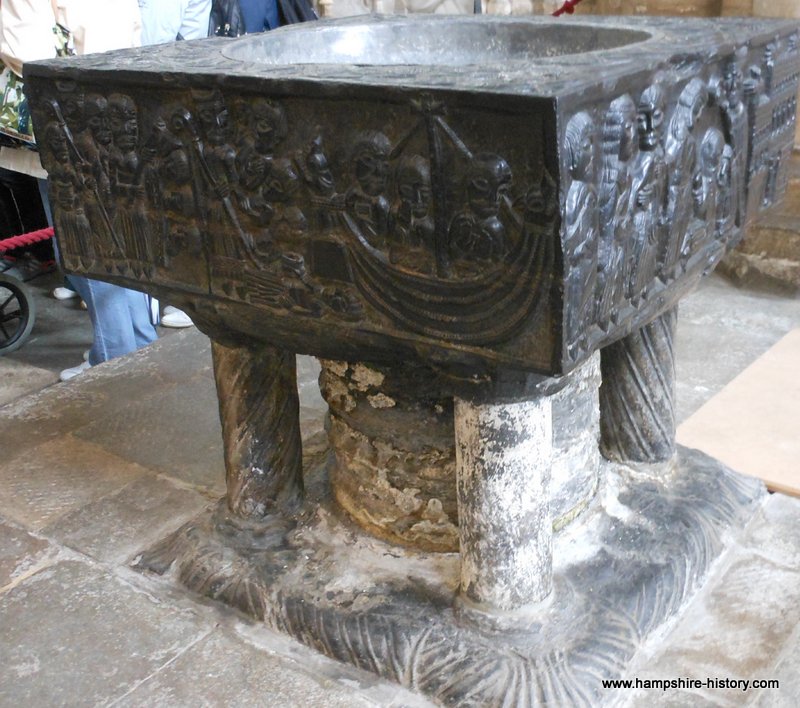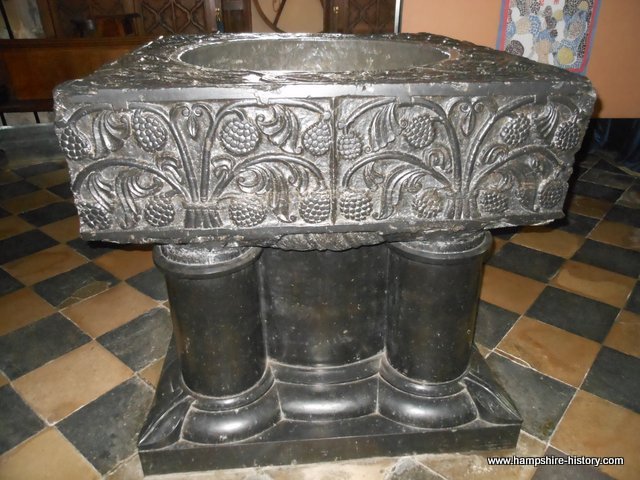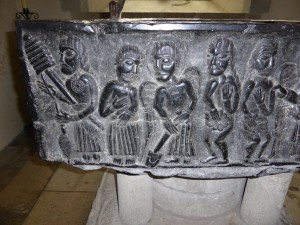There are four Tournai fonts in Hampshire, each a splendid example of the work of the C12th stone masons who carved them
Out of the hundreds of baptismal fonts in Hampshire only four are carved out of the black ‘marble’ from the area of Tournai in Flanders. This does not seem many until you learn that there are only seven to be found in the whole of England and then Hampshire seems to have a glut.
Tournai is located in the lowlands of Belgium at the southern limit of the Flemish plain, in the basin of the River Scheldt and is one of the oldest towns in Belgium and was a thriving trading economy as long as a thousand years ago.
Where are the Tournai fonts in Hampshire?
St Michael’s Church Southampton
St Peter’s Church St Mary Bourne
To find out more about each font, its decorations and likely provenance, click on the links above.
What is the Tournai Black Marble?
Contrary to its description as a black marble, Tournai stone is in fact a fine grained Lower Carboniferous,dark limestone which takes a polish. It has the appearance of marble when polished and hence its name. Provenence of black marble is not as straightforward as it might seem. Similar black “marble” was extracted from the Meuse valley in Belgium in the Middle Ages and there are other exploited sources in the UK and Ireland and elsewhere but the Tournai stone is different in its make up, it has a higher silica content and a different microfaunal content to the other black marbles. The stone used in the Tournai fonts in Hampshire can therefore be identified as Tournai marble.
Who were the Tournai craftsmen and why do we have examples of their work in Hampshire?
The school of Tournai stone masons seem to have been crafting baptismal fonts and headstones since the C11th. The fine grained limestone was an excellent material to work with but it is very hard and this is reflected in the styling seen on the English fonts.
The images carved on the fonts are low relief, with stylized figures showing quite graphic lines. This entirely reflects the hardness of the stone being worked.
Fresh out of the ground the stone carves with ease but after exposure to the air the stone with its high silica content becomes more difficult to work. It would have taken a deal of skill and strength to produce the decoration and it became a much sought after commodity. The dark black polish of its surface was also very attractive and unusual. Most Norman fonts in Hampshire are carved out of the vernacular stone, chalk or limestone. To be able to afford such a different and elaborately carved baptismal font would have given the church in which it was placed a very high status.
How did the fonts get to Hampshire?
In the C10th and C11th, trade between England and Flanders was flourishing. Bulk cargoes were being traded between the two regions on hulks that crossed the channel and could also navigate the large Flemish and English rivers. The goods were then carted to the large fairs. A Tournai Guild operated in Winchester and quite possibly they brought the fonts or the stone to show at the St Giles Fair in Winchester or to show directly to Bishop Henry de Blois, a great lover of fine art and architecture and thought to have gifted the font at East Meon to the church. All this a subjective but plausible view. The fonts would have been transported in kit form and then assembled on site. It could be that the stone alone was transported and then carved in Hampshire.
Discover more about Hampshire baptismal fonts on Hampshire History
Baptismal fonts are often the oldest objects in a church and have a tangible link with those living in a community, therefore we are collecting images of Hampshire fonts and including them in our postings.
Other Tournai fonts can be seen in England at Lincoln Cathedral, St Peter’s Ipswich and St Lawrence’s Thornton Curtis Lincolnshire.





